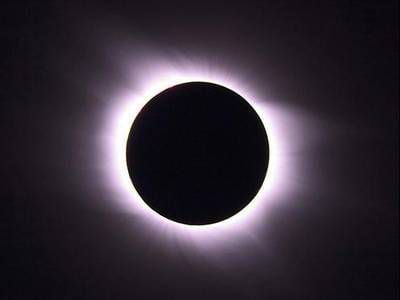You won’t have to fly your Learjet to Nova Scotia to see the next total eclipse of the sun on August 21, but you’ll have to leave Tucson.
Solar astronomer Matt Penn and a group of students from Cienega High School are getting ready to do just that.
Penn will be headed to Weiser, Idaho, for the Aug. 21 spectacle, where he will be operating one of 60 telescopes stationed along the line of totality from Oregon to South Carolina.
Penn is heading an effort by the National Solar Observatory, with cooperation from NASA, to create a continuous view of what is being billed as the All-American Eclipse. The team is known as the Citizen Continental-America Telescopic Eclipse Experiment — Citizen CATE for short.
The students from Cienega, members of an astronomy club at the Vail School District high school, will head to Nebraska with adviser Jack Erickson and one of Penn’s telescopes. They are part of an army of volunteer astronomers whose observations could lead to new discoveries about the sun’s chromosphere and corona.
If you don’t leave town, you will still be able to join in the fun. “It’ll be dark here, with about 65 percent partial eclipse,” said Penn.
In addition, Penn and NASA are planning to stream the event live on NASA-TV. He said the Cienega students plan to live-stream their observations to the Vail schools.
Solar eclipses are not rare. They occur every 18 months or so when the disk of the sun is fully covered by the shadow of the moon, as seen from somewhere on Earth.
The last eclipse visible from anywhere in the United States was in 1991. Tucsonans saw a partial eclipse that year.
What’s rare about this upcoming one is the continuous path that shadow will take — a 2,400-mile swath of the United States from the Pacific Ocean to the Atlantic that is home to about 10 million people.
A lot more than that are expected to travel to places along the path of the eclipse. Penn said officials in Weiser, Idaho, with a population of 5,333, are excited about attracting visitors but “a little worried that 600,000 people from Boise will be showing up.”
The path of totality is mostly rural, said Penn, but will pass over urban sections of the country such as St. Louis, Nashville and Charleston, South Carolina.
“A total solar eclipse is life-changing,” said Claire Raftery, head of education and outreach for the National Solar Observatory. “People have been known to burst into tears.”
Once the sun is totally blocked by the moon, you can take off your eclipse glasses, Raftery said. “You have about two minutes.”
With the sun’s illumination blocked, you can see the colors of the chromosphere and the “loops and streamers and beautiful symmetrical shapes” that outline the magnetic fields of the corona.
Another feature, called Baily’s Beads, allows you to see “little bubbles or blobs” along the rim of the moon. “We’re seeing the valleys and the mountains. It reminds me that the moon is a rock, it’s a physical body and not just a painting in the sky.”
Penn is hoping to observe more than the beautiful phenomena that an eclipse causes.
Astronomers have always used transits, passages of one body in front of another, to gather scientific information. It’s a good way to find exoplanets and it’s how scientists initially verified Einstein’s theory of relativity.
Penn said he hopes, with his continuous observations, to fill in some missing information about the sun’s corona, its outer atmosphere.
He is assembling 60 identical telescopes and cameras, training their operators and positioning them about 50 miles apart from Rosebud, Oregon, to Charleston, South Carolina.
The 80-mm refractor telescopes were donated by DayStar Filters, and the mounts by Celestron. MathWorks kicked in some cash and technical assistance with the software package.
The identical hardware and software will allow the team to combine the individual observations into a continuous 90-minute movie, weather permitting.
Weather is always a limiting factor in astronomical observations. Nobody forecasts weather this far out, but climate data show a greater than 50 percent chance of clear skies from the West Coast to Nebraska and a less than 50 percent chance east of there, Penn said.
While Penn can’t guarantee the weather, he does predict a resurgence of interest in solar astronomy.
To begin with, the volunteer observers will get to keep their equipment, courtesy of donations from the companies, individuals and nonprofit groups. Research Corp. in Tucson, for example, is helping to underwrite the Cienega students.
He has also written proposals to NASA and the National Science Foundation to fund academic partners — 22 universities and 22 high schools in the path of the eclipse, to join in continued observations of the sun, comets and variable stars.
He plans future combined observations of various astronomical phenomena, working with groups that study comets and variable stars, as well as the sun. “We’ll have 60 identical sets of equipment with trained, motivated users. The sky’s the limit,” Penn said.





